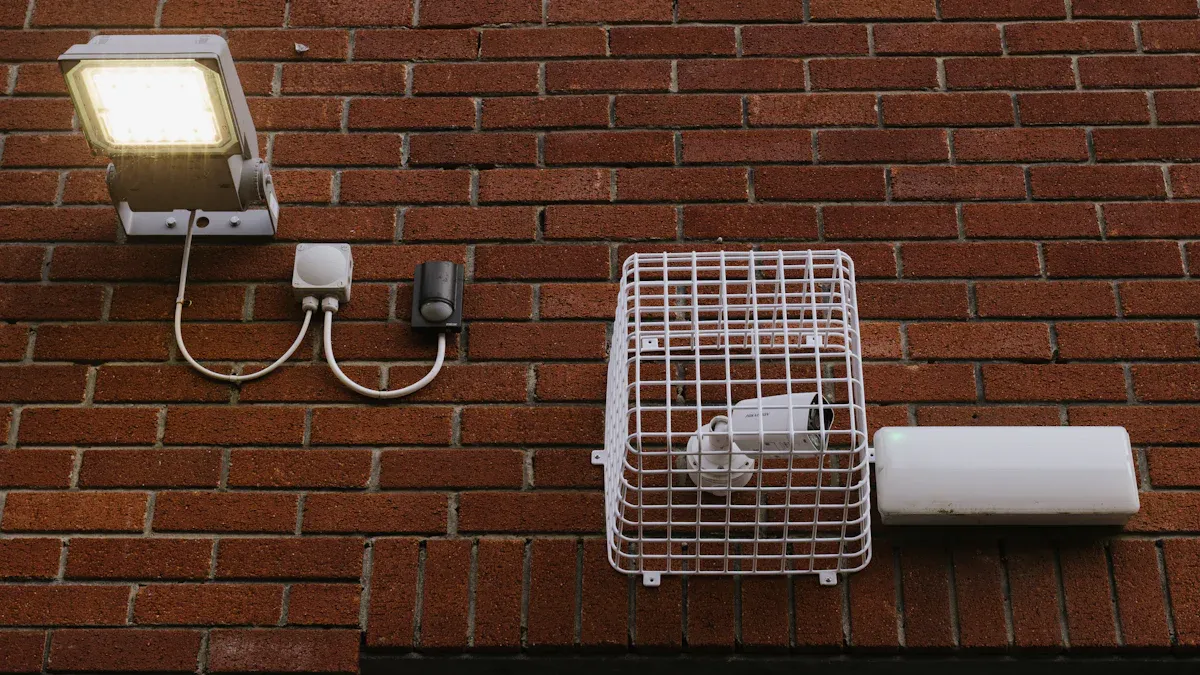
Security remains a critical concern for commercial property owners. Studies reveal that 75% of businesses now prioritize safeguarding their premises more than ever. This growing focus stems from the need to protect assets and ensure employee safety.
Motion sensor lights offer a practical solution to address these concerns. These smart security lights automatically detect movement, illuminating spaces only when required. This feature not only deters unauthorized access but also reduces energy consumption. By automating lighting based on occupancy, businesses benefit from lower energy costs and enhanced operational efficiency.
The transformative impact of smart systems, such as automatic lighting, extends beyond energy savings. They enhance convenience by eliminating manual operation and ensure power is utilized effectively. Businesses can also opt for induction lamps to further optimize their lighting setups, making them both efficient and eco-friendly.
Key Takeaways
- Motion sensor lights improve safety by lighting up when they sense movement. This helps stop unwanted entry.
- These lights save money on energy by working only when needed. You can cut costs by up to 70%.
- Motion sensors make life easier by turning lights on in used areas only.
- Using these lights is better for the planet. They use less power and lower pollution.
- These lights work well inside and outside, keeping places safe everywhere.
Understanding Motion Sensor Lights

What Are Motion Sensor Lights?
Motion sensor lights are advanced lighting systems designed to activate automatically when they detect movement within a specific range. These lights rely on sensors to identify changes in motion or heat, triggering illumination only when necessary. This technology eliminates the need for manual operation, making it a practical solution for commercial spaces.
Businesses often use motion sensor lights to enhance security and optimize energy consumption. These systems are particularly effective in areas like parking lots, hallways, and restrooms, where lighting is only required during occupancy. By ensuring lights remain off when spaces are unoccupied, companies can significantly reduce energy waste. For instance, a major retail chain reported a 25% reduction in energy costs within the first year of adopting motion sensor lighting systems.
How Motion Sensor Lights Work
Motion sensor lights operate using specialized sensors that detect movement or heat within their coverage area. The most common types of sensors include passive infrared (PIR), ultrasonic, and microwave sensors. PIR sensors detect infrared radiation emitted by warm objects, such as humans or animals. Ultrasonic sensors emit sound waves and measure the reflection to identify motion, while microwave sensors use electromagnetic waves to achieve the same purpose.
When the sensor detects movement, it sends a signal to the light fixture, prompting it to turn on. After a set period of inactivity, the light automatically switches off. This automation ensures energy efficiency and convenience. In commercial settings, these lights provide reliable illumination without requiring constant monitoring, making them ideal for high-traffic or sensitive areas.
Tip: Businesses can integrate motion sensor lights with existing security systems to create a comprehensive safety solution. This combination enhances both security and operational efficiency.
Top 6 Benefits of Motion Sensor Lights for Commercial Security

Energy Efficiency
Motion sensor lights offer a significant advantage in energy efficiency. These lights activate only when movement is detected, ensuring that energy is not wasted on unnecessary illumination. This feature is particularly beneficial in large commercial spaces like warehouses, where traditional lighting systems often remain on continuously. By using motion sensor high bay lights, businesses can drastically reduce energy consumption while maintaining adequate lighting when needed.
- Motion sensor lights help lower energy costs by reducing the time lights remain on unnecessarily.
- They contribute to eco-friendly practices by minimizing CO2 emissions.
- Businesses can align their operations with sustainability goals while enjoying reduced utility bills.
For example, in spaces such as storage areas or corridors, motion sensor lights ensure illumination only during occupancy. This targeted approach to lighting not only saves energy but also supports a greener environment.
Enhanced Security and Crime Deterrence
Motion sensor lights play a critical role in enhancing security and deterring criminal activity. Their ability to illuminate areas instantly upon detecting movement creates a sense of vigilance, discouraging unauthorized access. Studies have shown that improved lighting, including motion sensor systems, significantly reduces crime rates.
- A study in the UK reported a 21% reduction in crime due to better street lighting, which includes motion sensor lights.
- Enhanced lighting induces anxiety in potential criminals, making them less likely to target well-lit areas.
- Research from the University of North Carolina found that 60% of burglars would choose a different target if they noticed a security system in place.
By installing motion sensor lights in outdoor spaces, parking lots, and entry points, businesses can create a safer environment for employees and customers. These lights not only deter criminal activity but also provide peace of mind to property owners.
Cost Savings Over Time
The financial benefits of motion sensor lights extend beyond energy savings. These systems reduce operational costs by ensuring lights are only active when necessary. Over time, this efficiency translates into substantial cost savings for businesses.
- Private offices can achieve energy cost savings of 25-50%.
- Warehouses and storage areas see savings of 50-75%.
- Restrooms, corridors, and meeting rooms benefit from savings ranging between 30-65%.
By adopting motion sensor lights, businesses can optimize their lighting expenses while maintaining a secure and well-lit environment. The long-term savings make these systems a cost-effective investment for commercial properties.
Convenience and Automation
Smart motion sensor lights revolutionize the way businesses manage their lighting systems. These lights eliminate the need for manual operation by automating illumination based on occupancy. This automation not only saves time but also ensures that lighting is always optimized for the specific needs of a space.
Occupancy sensors, a key component of motion sensor lights, provide constant feedback to the system. This feedback allows businesses to integrate lighting with other systems, such as HVAC, for enhanced operational efficiency. For example:
| Evidence Description | Impact on Convenience and Automation |
|---|---|
| Sensors provide constant feedback to the system, influencing HVAC and lighting. | Ensures optimal performance and enhances user experience. |
| Motion sensors activate lights only when spaces are occupied. | Saves energy and reduces costs by preventing unnecessary lighting. |
Devices like Lutron motion sensor switches further enhance convenience by automating lighting control. These systems ensure that lights turn on only when needed, reducing energy waste and improving user experience.
Tip: Businesses can maximize the benefits of automation by strategically placing motion sensor lights in high-traffic areas, such as hallways and meeting rooms.
Eco-Friendliness and Sustainability
Motion sensor lights contribute significantly to environmental sustainability. By operating only when movement is detected, these lights reduce electricity consumption, leading to lower energy bills and a smaller carbon footprint. This eco-friendly approach aligns with the growing emphasis on sustainable business practices.
Key environmental benefits of motion sensor lights include:
- Energy Savings: These lights minimize electricity usage by activating only when necessary.
- Lower Carbon Footprint: Reduced energy consumption decreases carbon emissions from power generation.
- Extended Lifespan: Efficient operation increases the lifespan of lighting systems, reducing waste.
For businesses aiming to meet sustainability goals, motion sensor lights offer a practical and impactful solution. By adopting these systems, companies can demonstrate their commitment to environmental responsibility while enjoying long-term cost savings.
Versatility for Indoor and Outdoor Use
Motion sensor lights are highly versatile, making them suitable for both indoor and outdoor applications. Their adaptability ensures that businesses can enhance security and efficiency across various environments. Proper placement of sensors is crucial for maximizing their effectiveness in different settings.
For indoor use, motion sensor lights work best in high-traffic zones, such as offices, restrooms, and storage areas. These lights ensure that spaces are illuminated only when occupied, reducing energy waste. Outdoor applications, on the other hand, focus on enhancing security by illuminating dark areas, such as parking lots and building entrances.
Key features that enhance the versatility of motion sensor lights include:
- Ease of Installation: These lights can be installed in various locations, both indoors and outdoors.
- Battery-Powered Options: Outdoor models often include battery-powered designs, eliminating the need for nearby power sources.
- Durability: Outdoor sensors with IP65 ratings withstand harsh weather conditions, ensuring reliable performance.
PIR sensors, commonly used in motion sensor lights, perform well in both indoor and outdoor settings. For outdoor use, businesses should strategically place sensors to cover entrances and dark areas. Indoor sensors, meanwhile, should focus on high-traffic zones to maximize efficiency.
Note: Ninghai County Yufei Plastic Electric Appliance Factory offers a range of motion sensor lights designed for both indoor and outdoor use, ensuring businesses can find the perfect solution for their needs.
Overcoming Challenges with Motion Sensor Lights
Managing Initial Installation Costs
The upfront cost of installing motion sensor lights can be a concern for businesses. However, strategic planning and the use of energy-efficient technologies can mitigate these expenses. For instance:
- The ASHRAE 90.1 standard emphasizes energy savings through advanced lighting controls, including motion sensors.
- Combining motion sensors with LED lamps can reduce the total cost of ownership by up to 50.05%.
- Over the product lifecycle, LED fixtures extend the lifespan of lighting systems, minimizing replacements and waste.
Businesses should also consider the long-term benefits. Motion sensors can cut electricity consumption by as much as 97.92%, significantly lowering operational costs. By evaluating the entire lifecycle of lighting systems, companies can achieve both financial savings and environmental sustainability.
Ensuring Proper Maintenance
Proper maintenance ensures that motion sensor lights operate efficiently over time. Regular inspections and adjustments are essential to maintain optimal performance. Key maintenance practices include:
- Periodically checking and calibrating motion sensor settings.
- Scheduling inspections to verify sensor and light functionality.
- Documenting maintenance activities to meet industry standards.
Using energy-efficient lighting, such as LEDs, further reduces maintenance costs. Automated controls that adjust lighting based on occupancy also minimize unnecessary energy usage. Businesses should review and update their systems regularly to align with current energy efficiency benchmarks. These steps not only enhance performance but also extend the lifespan of the lighting system.
Integrating with Existing Security Systems
Integrating motion sensor lights with existing security systems enhances overall safety and operational efficiency. Modern technologies, such as Wi-Fi, Bluetooth, ZigBee, and Z-wave, enable seamless communication between motion sensors and security devices. This integration offers several advantages:
- Motion sensors can trigger alarms or activate cameras when movement is detected.
- LED security lighting combined with motion sensors strengthens security capabilities.
- Wireless connectivity ensures real-time responses to potential threats.
By incorporating motion sensors into their security infrastructure, businesses can create a cohesive system that improves response times and deters unauthorized access. Ninghai County Yufei Plastic Electric Appliance Factory provides innovative solutions designed to integrate seamlessly with commercial security setups, ensuring businesses achieve maximum protection and efficiency.
Smart motion sensor lights offer businesses a comprehensive solution for enhancing security and efficiency. Their six key benefits—energy efficiency, crime deterrence, cost savings, automation, eco-friendliness, and versatility—make them an indispensable tool for commercial properties.
- The global outdoor motion sensor light market, valued at $2 billion in 2022, is expected to grow by 8% annually, reflecting their rising demand.
- Properties with proper outdoor lighting deter up to 60% of intruders, showcasing their effectiveness in security.
- Energy usage reductions of 30-70% further highlight their long-term value.
Businesses can achieve these advantages by adopting high-quality solutions from trusted providers like Ninghai County Yufei Plastic Electric Appliance Factory.
FAQ
What types of sensors are used in motion sensor lights?
Motion sensor lights commonly use three types of sensors: passive infrared (PIR), ultrasonic, and microwave. PIR sensors detect heat, ultrasonic sensors use sound waves, and microwave sensors rely on electromagnetic waves to identify movement. Each type suits specific applications based on sensitivity and coverage.
Can motion sensor lights work in extreme weather conditions?
Yes, many motion sensor lights are designed for outdoor use and can withstand harsh weather. Models with IP65 ratings offer protection against dust and water, ensuring reliable performance in rain, snow, or extreme temperatures. Businesses should choose weather-resistant options for outdoor installations.
How do motion sensor lights save energy?
Motion sensor lights activate only when movement is detected, reducing unnecessary illumination. This targeted lighting approach minimizes electricity usage, lowers utility bills, and decreases carbon emissions. Businesses can achieve energy savings of up to 70% by replacing traditional lighting systems with motion sensor technology.
Are motion sensor lights compatible with existing security systems?
Yes, motion sensor lights integrate seamlessly with modern security systems. Technologies like Wi-Fi, Bluetooth, and ZigBee enable communication between sensors and devices. This integration allows lights to trigger alarms or cameras, enhancing overall security and operational efficiency for commercial properties.
How often should motion sensor lights be maintained?
Regular maintenance ensures optimal performance. Businesses should inspect sensors and light fixtures periodically, calibrate settings, and document maintenance activities. Using energy-efficient LEDs reduces the need for frequent replacements, extending the lifespan of the system and minimizing operational disruptions.
Tip: Ninghai County Yufei Plastic Electric Appliance Factory offers durable and energy-efficient motion sensor lights tailored for various commercial needs.
Post time: May-07-2025
